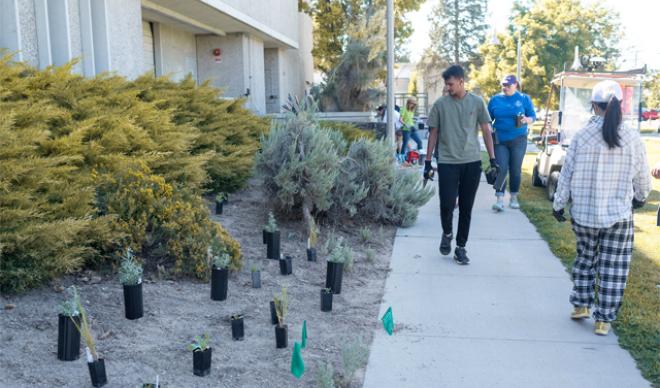
A summer research project at The College of Idaho could lead to immediate recognition while bolstering the long-term ecological outlook for the campus.
Led by Dr. Rob Laport of the biology department, a pair of students are working diligently this summer to improve the plant biodiversity around campus. The short-term goal is to achieve “Bee Campus USA” status as recognized by the Xerces Society. The bigger picture is to create natural vegetation on campus that supports native pollinators in southwestern Idaho.
The students, seniors Chessa-Grace Foreman and Kellin Hess, are both biology majors with a keen interest in bees. The two teamed with Laport, Brad Stokes from the University of Idaho, the groundskeeping staff at the College, and student volunteers to plant several plants, like sagebrush, around Boone Hall in June and hope to plant even more native plants later this summer.
“We’re hoping to see those coming up through the rest of the summer and into the fall,” Laport said. “But, especially in future years, those will continue flowering and provide those floral resources for our pollinators.”
Translation – a good habitat for bees. Pollinators, like bees, are vital for wildflowers and crops in the region. Without them, as many as 85 percent of flowering plants would be unable to produce seeds or fruits.
“There is a large amount of surrounding areas of farmland around Caldwell. These scattered farms and the farming community in the area would have nothing without the constant pollination work of the bees,” said Foreman, who grew up in Caldwell. “By focusing specifically on the native resources available across the entire community, even in the more densely populated areas, such as our campus, we introduce plants to sustain their work that we know are equipped for this environment and will have a lasting effect.”
That’s where Stokes and the groundskeepers at the College, led by Danny Trevett, come into play. June’s planting event was made possible through a grant from the University of Idaho, and under the guidance of Trevett, the team bought and then placed sagebrush plants and other native grasses.
Beyond possible recognition from the Xerces Society and the creation of natural habitats for pollinators, there’s yet another benefit to the planting efforts taking place this summer.
“The native vegetation that was planted generally requires less water to keep alive in this climate,” said Hess. “Which makes it a more sustainable choice than non-native landscaping.”
Plants native to this climate are used to the dry, hot summers, reducing the College’s water usage. Laport pointed out that his predecessor, Dr. Don Mansfield, planted sagebrush behind Boone Hall decades ago. Those plants are thriving to this day, paving the way for more plants to be added.
“That’ll pay dividends in our expenditures on campus and help us be more environmentally responsible,” Laport explained. “But it also provides a biodiversity repository for both native plants and native pollinators here in the Treasure Valley.”
Leaving something behind, beyond an award, is key to both Hess and Foreman.
"I feel like creating a shared task that benefits everyone gives students something to work towards together, even after Kellin and I are long gone from this campus," Foreman concluded. "We are leaving something behind for students to bond and grow over, and a way to give back to the community that we love."
Hess echoed that sentiment.
“Having these native plants can help students and visitors on campus appreciate the beauty of the plants that are native to Caldwell and this greater area,” she said.
To see more images from June's planting event, visit the College's Flickr page.
The College of Idaho has a 133-year-old legacy of excellence. The College is known for its outstanding academic programs, winning athletics tradition, and history of producing successful graduates, including eight Rhodes Scholars, three governors, and countless business leaders and innovators. Its distinctive PEAK Curriculum challenges students to attain competency in the four knowledge peaks of humanities, natural sciences, social sciences, and a professional field—empowering them to earn a major and three minors in four years. The College’s close-knit, residential campus is located in Caldwell, where its proximity both to Boise and to the world-class outdoor activities of southwest Idaho’s mountains and rivers offers unique opportunities for learning beyond the classroom. For more information, visit www.collegeofidaho.edu.